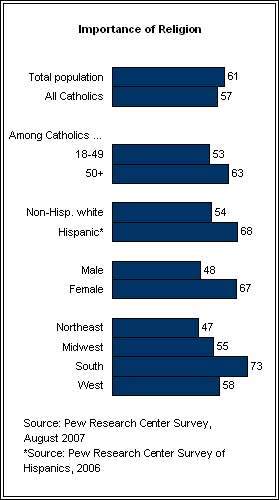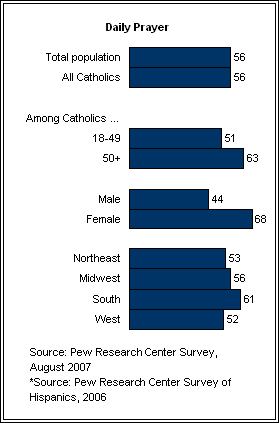Catholics generally mirror the general population when it comes to basic measures of religious commitment (e.g., church attendance, importance of religion and frequency of prayer). But there are major differences among Catholics when it comes to the practice of their faith. Results from a summer 2007 poll by the Pew Forum and the Pew Research Center for the People & the Press illustrate these distinctions.
Church Attendance Importance of Religion Frequency of Prayer Renewalism Among Hispanic Catholics
Church Attendance
The similar percentage of Catholics (41%) and the public overall (38%) who say they attend church at least once a week, for instance, obscures the differences among Catholics on this measure. For example, there is a noticeable age gap; younger Catholics are significantly less likely than their older counterparts to attend church weekly or more often. Less than a third (30%) of Catholics ages 18-29 attend church this frequently, compared with nearly two-thirds (63%) of Catholics age 65 and older. A similar pattern is seen among the public overall, with older people more likely than their younger counterparts to attend church regularly.
Significant differences also exist among Catholics living in different regions of the country. Just over one-third (37%) of Northeastern Catholics attend church at least once a week, for example, while more than four-in-ten (45%) Midwestern Catholics attend church this frequently.

Women are eight percentage points more likely to attend services weekly than men (45% vs. 37%). Latino Catholics and white Catholics, however, report very similar levels of church attendance; 42% of each group say they attend church weekly.
Importance of Religion

More Catholics say religion is very important in their lives (57%) than the number who say they attend church at least once a week (41%). Among the general population, the number saying religion is very important is similar (61%), but the proportion saying it is somewhat important in their lives is smaller (24%) than among Catholics (33%). Fewer than one-in-ten Catholics say religion is not too or not at all important in their lives.
Looking at different subgroups of Catholics, the percentage of Catholics age 50 and older who say religion is very important in their lives is 10 percentage points higher than the number for the under-50 group. And the number of women who say religion is very important in their lives is nearly 20 percentage points more than the number of men who say this. Similar age and gender differences are found among the public overall.
There is also a 14-point gap between white, non-Hispanic Catholics and their Hispanic counterparts; 54% and 68%, respectively, say religion is very important in their lives.
Regional differences among Catholics are also quite stark. Just under half of Northeastern Catholics (47%) say religion is very important in their lives, compared with nearly three-quarters (73%) of Catholics in the South. Midwestern and Western Catholics come in at 55% and 58%, respectively.
Frequency of Prayer

Catholics pray with a similar frequency as the general public (56% of each group does so every day) but, again, a closer look shows significant differences among subsets of the Catholic population.
While 63% of Catholics age 50 and older say they pray at least once a day, the number is only 51% for Catholics under age 50. Women are significantly more likely than men to pray daily; 68% of Catholic women say they pray every day, compared with 44% of Catholic men. At least half of Catholics in every geographic region say they pray every day.
Renewalism Among Hispanic Catholics
Latino Catholics are helping to reshape the Catholic Church in the U.S. not only through their sheer numbers but also through their distinctive forms of worship. More than half (54%) of Hispanic Catholics identify themselves as charismatics, compared with only 12% of white, non-Hispanic Catholics.
Masses attended by Latino Catholics often exhibit the kind of exuberant atmosphere that is more characteristic of Pentecostalism or other forms of charismatic or renewalist Christianity than of traditional American Catholicism. Among Latino Catholics who attend church services, for example, more than six-in-ten (62%) say that the Masses they attend at least occasionally include displays of excitement and enthusiasm, such as the raising of hands, clapping, shouting or jumping, according to a survey conducted in 2006 by the Pew Forum and the Pew Hispanic Center.
Charismatic Christians place a special emphasis on divine healings, direct revelations from God, exorcisms and other signs of God’s ongoing, day-to-day intervention in human affairs. Nearly half (45%) of Hispanic Catholics say they have received or witnessed a divine healing, compared with only 21% of non-Hispanic Catholics. Similarly, roughly a third (31%) of Hispanic Catholics claim to have received a direct revelation from God; the figure is 12% for non-Hispanic Catholics. Few Catholics have experienced or witnessed an exorcism, but more than twice as many Latinos (14%) say they have done so as do non-Latinos (6%).

It is important to point out that the adoption of some key features of pentecostal or charismatic Christianity by Hispanic Catholics does not appear to be undermining their commitment to Catholicism. The proportion of Latino Catholics who say they could never leave the Catholic Church is virtually the same among those who identify as charismatic (73%) as among those who do not (74%). In short, Latino Catholics seem to be incorporating charismatic practices without displacing their traditional Catholic identity. Moreover, charismatic Latino Catholics are somewhat more likely to serve in their parishes in volunteer capacities (e.g., as lectors, Eucharistic ministers, members of the choir or parish council, or leaders of small groups) as compared with non-charismatic Latino Catholics.
Large percentages of all Latino Catholics – charismatics and non-charismatics alike – embrace the church’s traditional beliefs and practices. Nearly nine-in-ten Latino Catholics, for instance, believe that in the Mass the bread and wine become the body and blood of Christ – a core Catholic belief. More than eight-in-ten say they pray to the Virgin Mary. A sizable number of Latino Catholics (43%) also say they pray the rosary at least once or twice per month, and 43% say they go to confession at least a few times per year.
Photo Credit: Mario Tama/Getty Images




